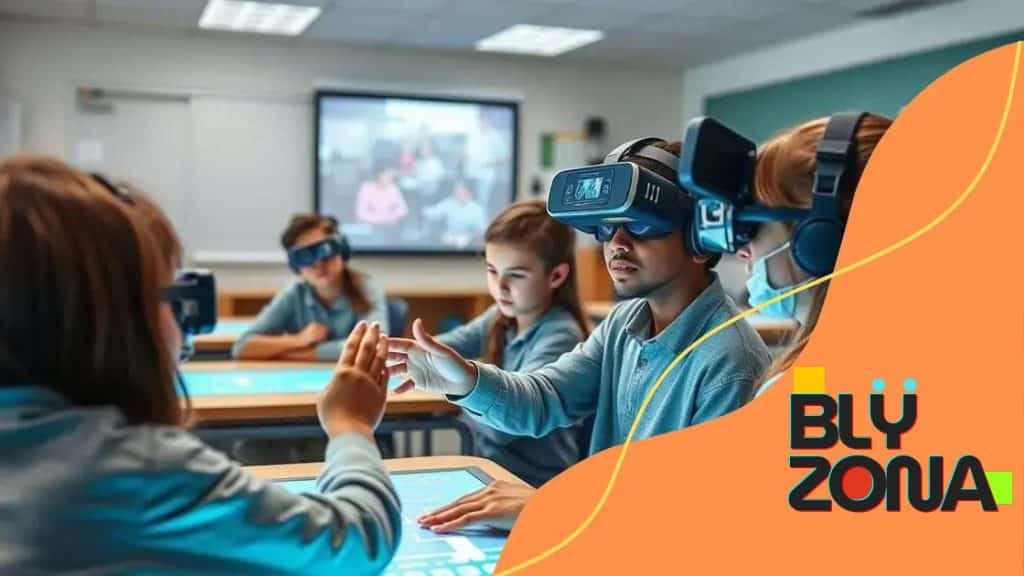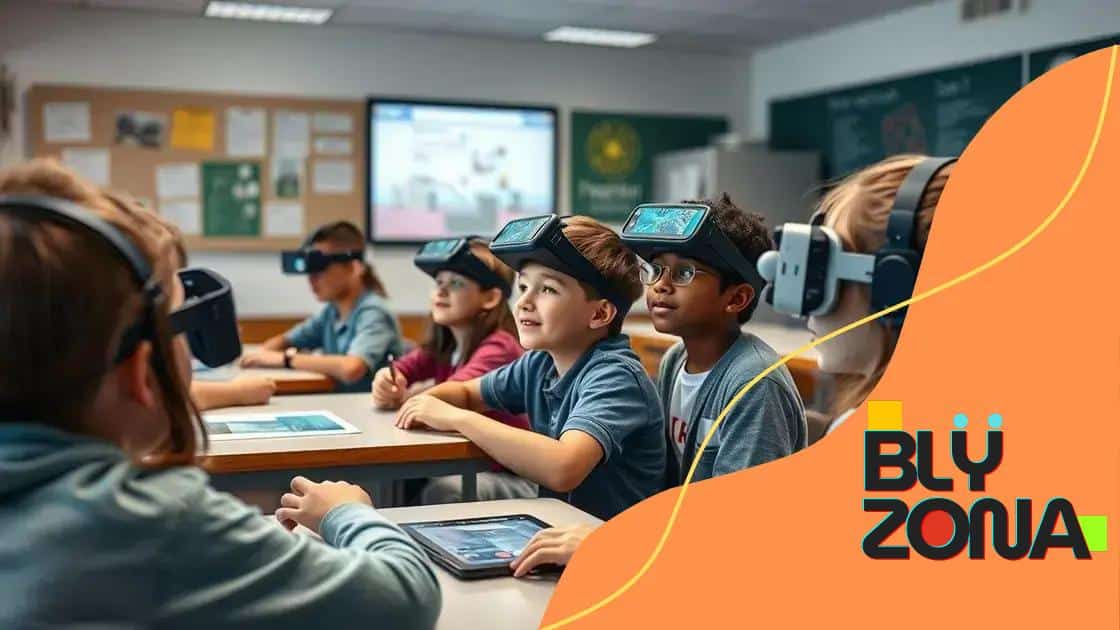How AR is being used for hands-on learning experiences

Augmented reality (AR) enhances hands-on learning experiences by creating interactive, immersive environments that cater to diverse learning styles and improve student engagement and understanding.
How AR is being used for hands-on learning experiences is changing the face of education. Imagine students immersing themselves in interactive lessons that enhance understanding and retention. Curious about how this works? Let’s dive in!
The benefits of augmented reality in education
Augmented reality (AR) offers numerous benefits that can enhance the educational experience. By merging digital content with the real world, AR enables students to engage in more interactive and immersive learning.
This technology makes complex concepts easier to grasp. For instance, students studying biology can visualize cell structures through 3D models. They can explore every detail as if it were right in front of them. This level of engagement leads to improved retention and understanding.
Interactive Learning Experiences
AR transforms passive learning into an active experience. Students can participate in lessons that captivate their attention and spark their curiosity. Such engagement often results in a deeper interest in the subject matter.
- Real-time feedback during learning activities.
- Hands-on learning opportunities without the need for physical materials.
- Collaboration and teamwork are encouraged through shared AR projects.
Furthermore, AR in education caters to various learning styles. Visual learners benefit from seeing 3D representations, while tactile learners can manipulate virtual objects. This adaptability ensures that all students can find something that resonates with them.
Accessibility and Engagement
Another significant advantage of AR is accessibility. Students from diverse backgrounds can access the same quality of materials, regardless of their physical location. With AR, everyone can participate in realistic simulations that would be challenging to recreate in a classroom.
Lastly, the incorporation of AR fosters engagement at an early age. Kids today are familiar with technology, and using AR makes learning exciting. When students look forward to lessons, they are more motivated to learn and excel.
The potential for enhancing educational experiences through augmented reality is immense. As more schools adopt this technology, the future looks promising for both educators and students alike, paving the way for a more interactive learning environment.
How AR enhances practical skills
Augmented reality (AR) plays a crucial role in enhancing practical skills among students. By providing a safe and interactive environment, AR bridges the gap between theory and real-world application. This technology allows learners to practice skills in a simulated setting before trying them in real life.
For instance, in vocational training, AR can help students learn complex tasks such as carpentry or plumbing. They can visualize the steps required to complete a project without the risks associated with handling tools. This kind of immersive training improves confidence and competence.
Real-World Simulations
AR applications create real-world simulations that closely mimic the actual work environment. Students can engage with these simulations at their own pace, allowing for experimentation and practice without fear of making mistakes.
- Practicing medical procedures in a controlled setting.
- Learning how to operate machinery safely.
- Engaging in customer service scenarios that develop communication skills.
This practical experience is essential for developing motor skills and cognitive abilities. As students manipulate virtual objects or navigate through complex scenarios, they build muscle memory and decision-making skills.
Feedback and Assessment
Another significant aspect of using AR in skill enhancement is the immediate feedback provided to learners. As they complete tasks, AR technology can assess performance in real-time, pinpointing areas for improvement. This instant feedback loop helps students understand their mistakes and correct them right away.
Moreover, instructors can track progress more effectively. This visibility allows teachers to tailor their lessons to meet the individual needs of their students, ensuring everyone can develop the required skills at their own pace.
With augmented reality, the fusion of learning and doing creates a powerful tool for skill development. As educational institutions continue to integrate AR into their curricula, the ability to acquire and refine practical skills will enhance considerably, preparing students for their future careers.
Case studies of successful AR implementations

Case studies of successful augmented reality (AR) implementations showcase the potential of this technology in education. Various schools and organizations have adopted AR to enhance learning experiences, leading to remarkable outcomes. These stories illustrate how AR can translate innovative ideas into effective teaching methods.
One notable example is a school that integrated AR into its science curriculum. Students used AR applications to explore the solar system. They could see how planets orbit the sun in real-time, making theoretical concepts tangible. This approach increased student engagement and helped them retain complex information.
Real-World Examples
Another instance involves a vocational training center that utilized AR to train future mechanics. Using AR, students could see virtual overlays of car engines while learning to repair them. This method allows learners to visualize parts and processes, enhancing their understanding and skills.
- A school that taught history through AR experiences, bring historical events to life.
- A healthcare program that used AR for simulating surgeries, allowing students to practice without risk.
- An architecture class where students designed buildings that they could view in AR, analyzing their designs in real space.
These cases highlight the broad applications of AR in education. The students not only learn but also practice in a way that mirrors real-world environments. When learners engage with content actively, they are more likely to understand and remember it. As educators observe positive results, more institutions are eager to adopt similar technologies.
Impact on Learning and Engagement
Moreover, these implementations have led to higher levels of student satisfaction and motivation. Learning becomes a fun and interactive process, encouraging students to take initiative and explore new concepts. AR fosters a sense of wonder as they dive into subjects previously deemed dull or complex.
As we analyze these success stories, it’s evident that augmented reality is not just a passing trend. Instead, it’s paving the way for future educational practices that combine technology with immersive experiences. The ongoing research and development will likely lead to even more innovative uses of AR in various educational contexts.
Challenges in adopting AR technology
Adopting augmented reality (AR) technology in educational settings presents several challenges that institutions must navigate. While the benefits are clear, the path to successful implementation can be complex and requires careful planning.
One major challenge is the cost of technology. Implementing AR often requires significant investment in hardware and software. Schools may struggle to allocate funds, especially in districts with tight budgets. Ensuring that all students have access to compatible devices is crucial for equal learning opportunities.
Technical Issues
Another obstacle involves technical issues related to software integration. Teachers may face difficulties incorporating AR into existing curricula or may not have the technical skills needed to use new tools effectively. Professional development programs can help, but they require time and commitment from educators.
- Ensuring reliable internet connectivity for AR tools.
- Integrating AR with current educational technologies.
- Providing ongoing support and maintenance.
Additionally, there can be a learning curve for both students and teachers. While many students are tech-savvy, they may not be familiar with AR applications. Educators must provide adequate training to help everyone feel comfortable using these tools.
Acceptance and Resistance
Furthermore, there may be resistance from stakeholders who are hesitant to embrace new technologies. Parents and educators sometimes worry about the effectiveness of AR versus traditional teaching methods. Clear communication about the benefits and evidence of success can help alleviate concerns.
Finally, curriculum alignment can pose a challenge. Not all subjects or lessons lend themselves to AR integration. Educators need to identify which areas can benefit from AR without overwhelming students. Balancing traditional teaching methods with innovative technologies requires careful consideration.
Despite these challenges, the potential rewards of incorporating AR into education are significant. By addressing these barriers, schools can create a more engaging and effective learning environment that excites students and enhances their educational experience.
Future trends of AR in learning environments
The future of augmented reality (AR) in learning environments is bright and full of exciting possibilities. As technology continues to advance, we can expect AR to play an even more significant role in education, transforming how students interact with information.
One promising trend is the evolution of AR applications that provide personalized learning experiences. Learners will be able to engage with customized content that matches their individual learning styles and paces. This personalized approach helps students grasp concepts more effectively and retains their interest.
Collaborative Learning Opportunities
Another emerging trend is the rise of collaborative AR experiences. Students will have the chance to work together on projects in shared virtual environments. Such collaborative interactions foster teamwork and communication skills, which are essential in today’s work environments.
- Virtual field trips enabling students to explore historical sites together.
- Group projects where students can create and manipulate virtual objects.
- Interactive lessons that allow for real-time feedback from peers and instructors.
As AR technology becomes more accessible, schools will implement it across various subjects. Science classes may use AR to conduct virtual experiments, while history lessons could incorporate immersive storytelling experiences. This broader application enhances engagement and offers practical learning in multiple disciplines.
Integration with Other Technologies
Furthermore, AR will likely integrate seamlessly with other technologies. For example, combining AR with artificial intelligence (AI) could lead to even more dynamic educational experiences. AI can analyze student performance and adapt AR content accordingly, tailoring lessons to meet individual needs.
In addition, advancements in virtual reality (VR) and mixed reality may further enhance AR experiences. As these technologies converge, they can create richer, more immersive learning environments. Students will find themselves in controlled yet realistic settings, where they can explore and learn without limitations.
Lastly, the future will also see AR being used for non-traditional learning scenarios. Adult education and professional training programs may incorporate AR to enhance skill development and career preparation. This shift acknowledges that education isn’t restricted to the classroom but continues throughout life.
FAQ – Frequently Asked Questions about Augmented Reality in Education
What are the main benefits of using AR in education?
AR enhances student engagement and understanding by providing interactive and immersive learning experiences that cater to different learning styles.
What challenges do schools face when adopting AR technology?
Schools often struggle with costs, technical issues, and resistance from stakeholders when trying to integrate AR into their curricula.
How does AR personalize learning for students?
AR applications can tailor content to individual learning paces and styles, allowing each student to engage with materials that best suit their needs.
What future trends can we expect from AR in learning environments?
Future trends include increased collaboration through shared AR experiences, deeper integration with other technologies, and broader applications across various subjects.





